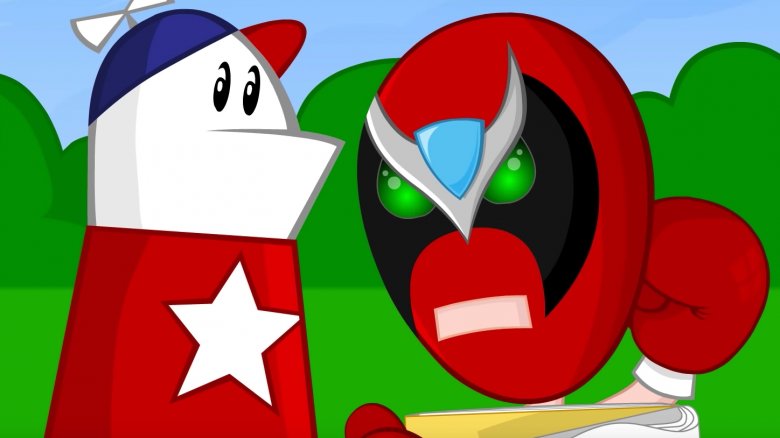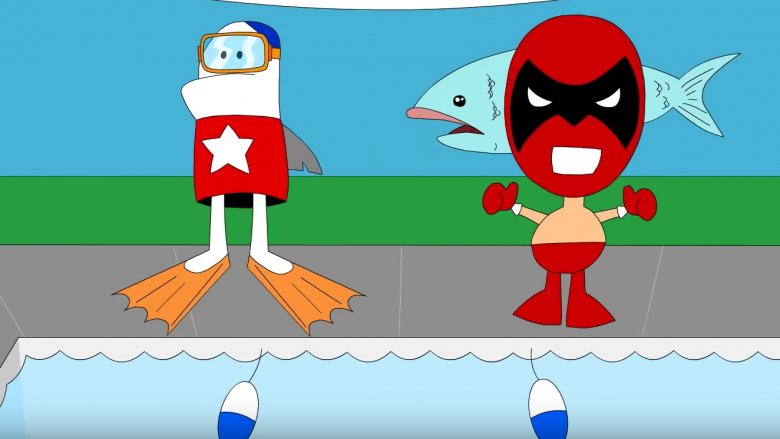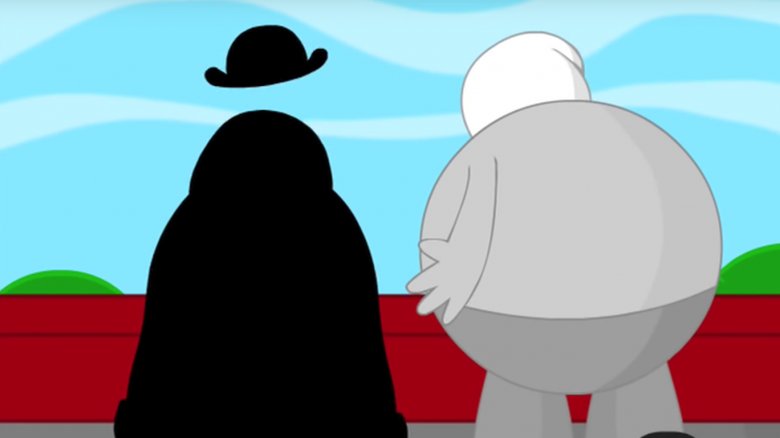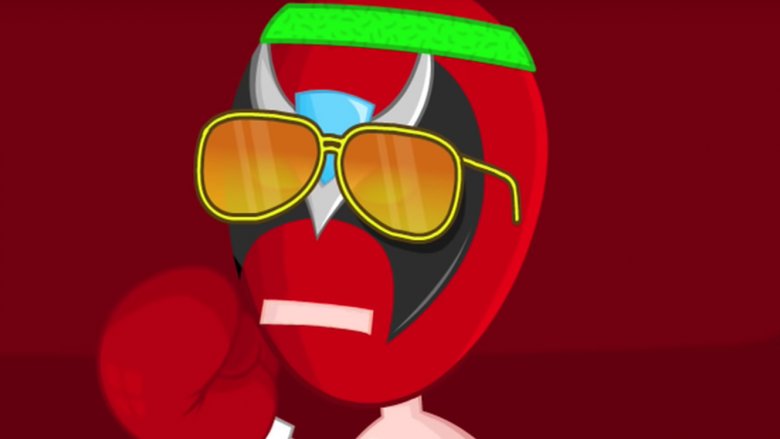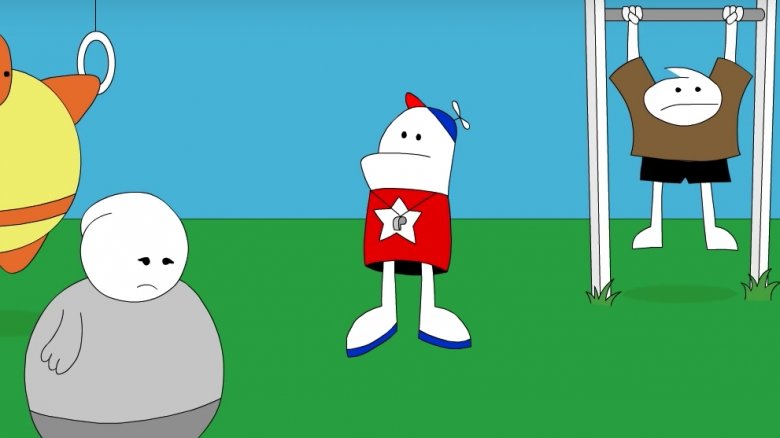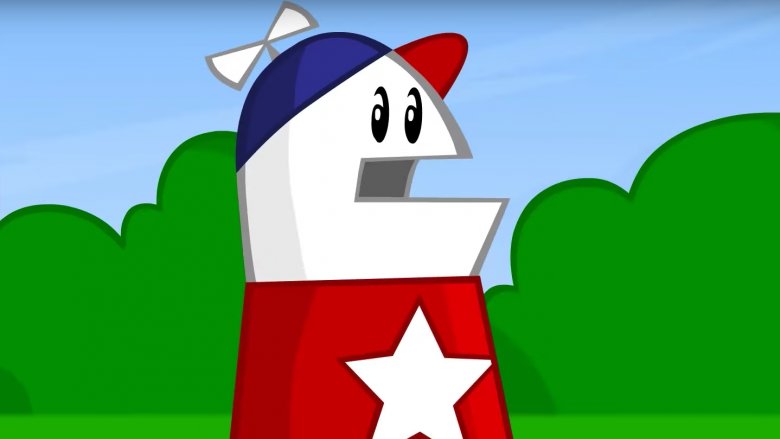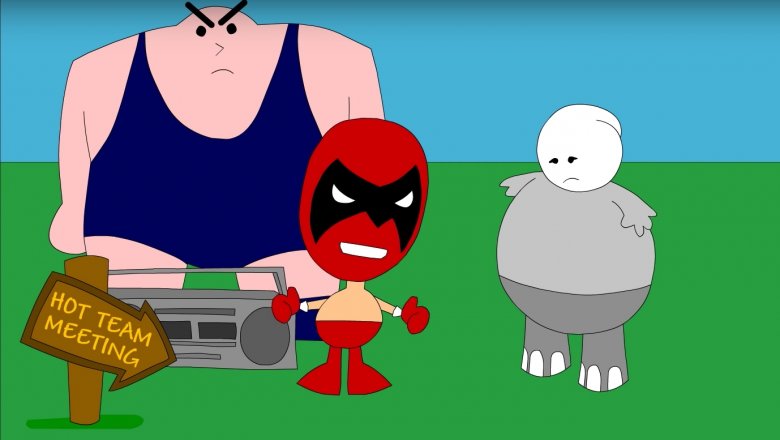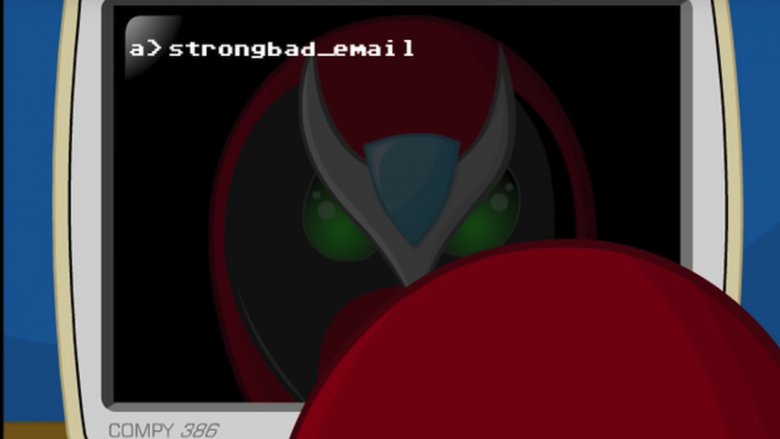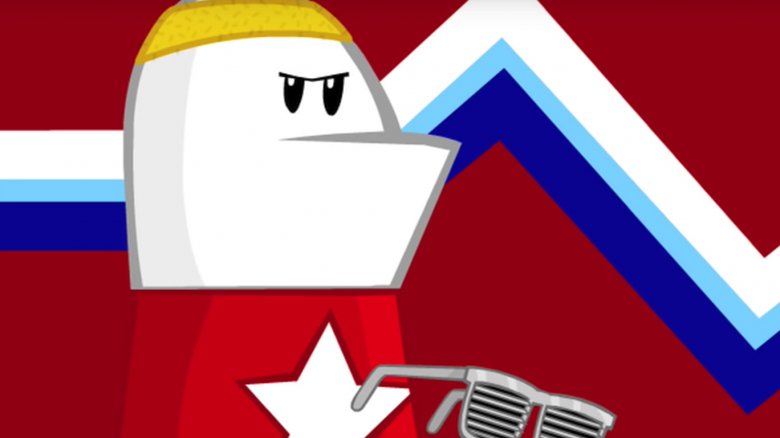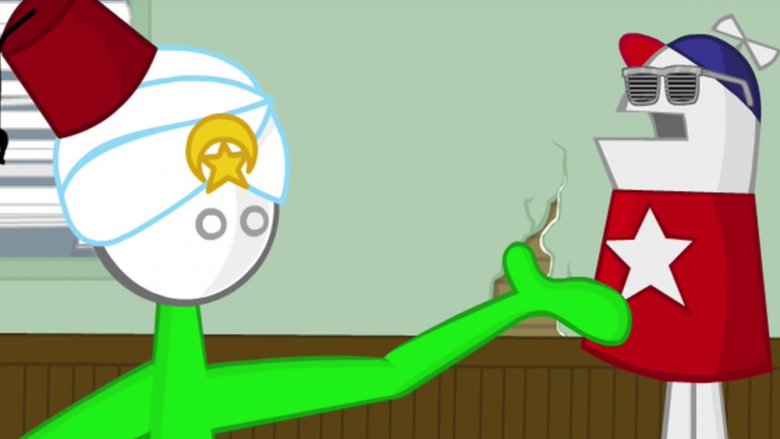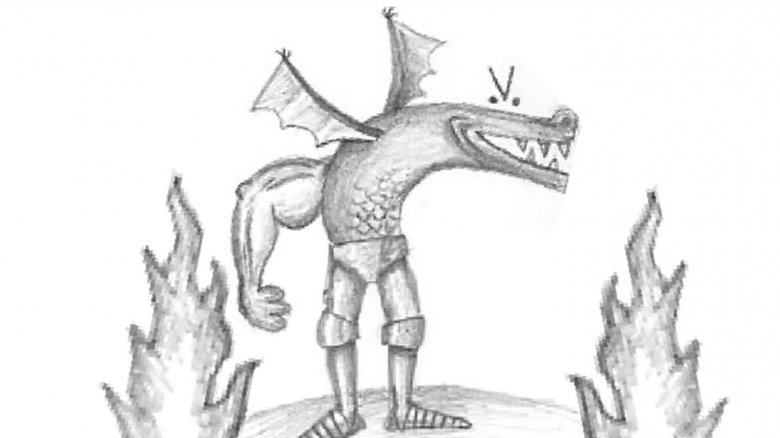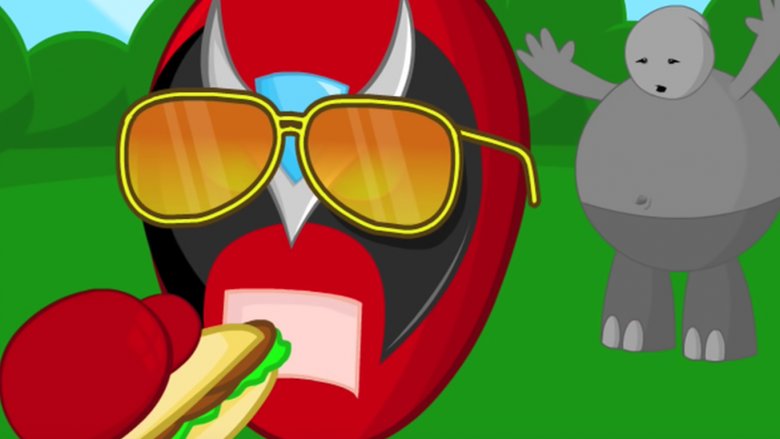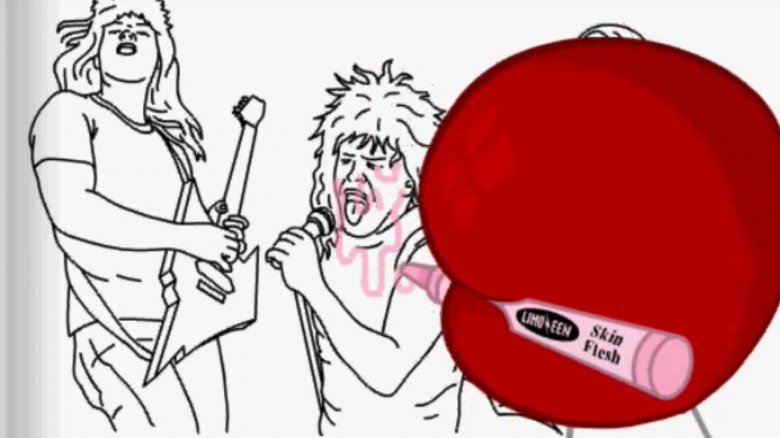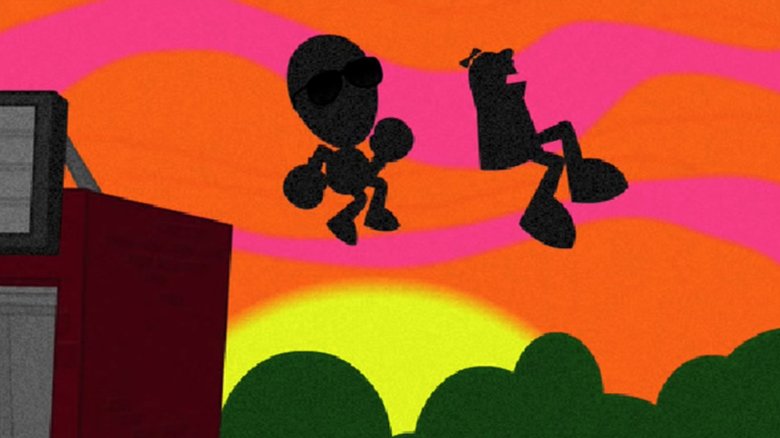The Untold Truth Of Homestar Runner
There's no doubt that '80s nostalgia is thriving in today's pop culture landscape. But while this resurrection is fairly new for most, there was one 21st century phenomenon that was far ahead of the game: Homestar Runner. This retro-infused online sensation had its glory years between 2000 and 2010, captivating the pre-YouTube internet with its offbeat characters, its simple cartooning, and its... Strong Bad (yes, he gets his own category).
During the early years of the internet phenomenon, millions flocked to the beloved website on a regular basis to view the endless procession of entertaining webisodes, games, and fan mail responses starring Homestar Runner, the Cheat, Strong Bad, Marzipan, and the rest of this lovable bunch of misfits. But while the videos themselves are an iconic part of those early days of being online, the story of their creation is one that also captivates the imagination. Who exactly are the brothers who created these absurdly entertaining personas? How did the show evolve over time? What was the key to its success? And, of course, how did it all begin?
Where it all started
Homestar Runner started out as a kids book. Created by brothers Matt and Mike Chapman and their filmmaker friend Craig Zobel during the Summer Olympics in 1996, the book (which can still be seen in semi-animated form) was called The Homestar Runner Enters the Strongest Man in the World Contest. It introduced static versions of such beloved characters as Homestar Runner, Pom Pom, and the Cheat. Strong Bad was there too, playing a straight-up villain in his premiere role.
The story was short and simple, following champion athlete Homestar Runner as he attempted to carry the most grapes — yes, grapes — in order to win the "Strongest Man" competition. The pair of writers wanted it "to feel like it was from another country or poorly translated from Japanese," as Mike reminisced in an interview with Adventure Gamers. After taking a couple of hours to craft the characters, they finished the book in a single day, showing both a flair for speedy production and the trademark offbeat comedy that would come to define the site. They printed a few copies for their friends, and eventually made a short animation based on Homestar using Mario Paint.
From book to screen
A few years after the book, Flash animation began growing in popularity, and the Chapman brothers, also known as "The Brothers Chaps," began to think about the possibilities. This wasn't a one-off conversation, either — the pair believed in the potential so much that Mike actually dropped out of grad school in order to start teaching himself the new animation style.
But, of course, in order to produce a video, they needed something to put in it, and they decided to go back to their old children's book for inspiration. Thus it came about — not by planned forethought and execution but rather by some friends goofing off and a gutsy decision to drop out of college — that Homestar Runner found his way off the page and onto the screen. The cartooning of the book was simple, and it proved the perfect subject to use for animation practice. With Mike animating and Matt doing the voice overs — along with Mike's then-girlfriend (and later wife) Missy Palmer, who provided the voice of Marzipan — the new venture was off to the races. The website launched in 2000, initially serving simply as a place to house some of the videos they were creating.
Aesthetic inspirations
When it comes to the bones of the Homestar Runner animation itself, there are a couple of important factors at work, aside from the simple look that made the Flash animation so quick and easy to constantly pump out. For one thing, Matt Chapman has pointed out that their original inspiration came from popular kids shows at the time of Homestar's creation, such as Dexter's Laboratory or Powerpuff Girls. It doesn't take much observation to see the influence of both of these kid classics at work in the unique style of web animation that the brothers cooked up.
But it wasn't just the visual inspiration that gave HR such an endearing feel. The attraction was also partly due to the simplistic, purposefully low-quality approach taken for both the vocals and the music. The low-budget musical quality was literally made "with old Casio keyboards or worse," while the childish vocal deliveries were reminiscent of popular shows like South Park (though the Chapmans' content tended to be a bit on the cleaner, more family-friendly side).
The origin of Homestar
One of the oddest things about Homestar Runner is the name itself. With no obvious connection to anything collectively recognizable, where exactly did this peculiar (if endearing) name come from? Believe it or not, it originated from an inside joke that came about when a group of kids innocently made fun of a bad commercial. Mike Chapman explained that the name found its origin when one day the brothers were hanging out with their friend James Huggins, who went on to become a member of the band Of Montreal.
James was not athletically inclined, and when he attempted to reference a terribly-made commercial that starred Mark Lemke of the Atlanta Braves, he tried to use terminology that was simply out of his experience, blurting out something along the lines of "Homestar runner for the Braves Mike Lemke!" Everyone has that friend who tries to sound like they know what they're talking about, but how often can they lay claim to being the unintentional inventors of a name as popular as Homestar Runner? That, friends, is power. The name obviously stuck in the minds of the Brothers Chaps, and they tucked it away for later use.
Homestar's arms, or lack thereof
One bothersome question that has always stood front and center with Homestar Runner is the lead character's puzzling lack of arms. It's not like this is VeggieTales, with everyone purposefully lacking upper appendages and getting by just fine in spite of it. Most of the other characters surrounding Homestar have arms, even if many of them are missing hands or perpetually wearing boxing gloves. But while the lack of arms has never slowed Homestar Runner down, the question still stands — why?
The answer, in this case, is right in the name itself. As Mike Chapman pointed out, Homestar was created to be an excellent athlete — not just an athlete, but a runner in particular. Since he was designed to run, why would he need arms? The logic is about as simple as it gets, but it checks out. And since it comes from the creator, it's as definitive an answer as you're likely to find. Homestar doesn't have arms because he was designed to run. Next question, please.
The origin of the Strong clan
Strong Bad, Strong Mad, and Strong Sad make up the Strong Brothers Three, with the trio showing up in numerous videos and always causing some kind of havoc and humor. But while the characters have their own extremely unique qualities within the Homestar Runner-verse, they aren't actually made up from scratch. It turns out that the entire idea of the "Strong Clan" is actually borrowed from a team of wrestlers that appeared on the '80s NES game Tag Team Wrestling.
The game follows two different wrestling tag-teams, the Ricky Fighters and the Strong Bads, with one of the latter literally wearing a red Lucha Libre mask that is clearly the inspiration for the beloved Homestar character. After adapting yet another '80s pop-culture reference into the show in the form of Strong Bad, it was just a matter of time before the ever-depressing Strong Sad and the childishly angry Strong Mad arrived on the scene, and the whole Strong brotherhood was officially born into existence.
Strong Bad emails are real
For a while, the Homestar Runner website clicked along steadily with a small audience, but eventually, the Champans realized they were making it big — all thanks to Strong Bad's emails. The endless procession of shorts that showcased Strong Bad answering bizarre emails with sometimes nonsensical answers proved to be the pivotal turning point that turned Homestar Runner into an internet sensation.
The shorts were initially created as a kind of "filler content" that could be quickly produced on a weekly basis while other, bigger shorts were in the works. But, in the end, it was these Strong Bad email segments that captivated audiences around the globe. The brothers even started to get messages from upset fans when the shorts didn't air on time, leading them to the realization that they had officially become "as important as a cup of coffee or morning crossword" to a lot of their fanbase.
The best part about the Strong Bad emails, though, is that they were genuine emails from real fans (with the single exception of email #87, "Mile," which the Cheat made up). A fan actually getting their email answered by Strong Bad, though, was tough, with the brothers making it clear that they picked what they thought was the best candidate, while the rest went into the dustbin.
Parents to the rescue
While the Chapman brothers have been at the heart of all things Homestar Runner over the years, the truth is, they probably never could have pulled off what they did (and on the scale that they did) without a little bit of help. This came, in particular, from their parents, who were supportive of their endeavors right from the get-go. For example, remember when they made the initial book and printed off a handful of copies for their friends? It turned out that, without telling them, their father actually sent off copies to upwards of 80 different publishers, and even if none of these were accepted (in fact, few even responded), it does showcase their parental support from an early stage in development.
Their parents also allowed the brothers to literally consume their home with the burgeoning business as things like production and fulfillment of merch orders steadily claimed more and more room throughout the house. Their father worked alongside his sons to serve as their accountant and to help them manage the copyrights for their characters. He was even a driving force behind convincing Matt to quit his job in 2003 in order to pursue HR full-time. While many parents have supported their children's dreams over the years, there's little doubt that the Chapmans' folks were more supportive than most.
No marketing, no ads
When you hear of a site that's getting hundreds of thousands (sometimes even millions) of visitors, it's only natural to wonder how the webmasters have monetized that traffic. But, while the Chapman brothers did, indeed, made a living off of Homestar Runner for the decade or so that its star was on the rise, the success was shockingly stripped of any of the banner ads and other e-doohickeys that typically help bring in the cash. The brothers were never big fans of ads, and they decided early on to deliver a genuinely entertaining product sans the advertising fanfare.
How did they make their money they? With merch. At times they literally had fans clamoring for shirts, hoodies, and other merchandise emblazoned with their favorite online heroes. It was the sale of Homestar Runner products that kept that the site alive for years. In addition to the lack of ads, the site was never even marketed. There was no giant investor delivering piles of cash, no Google Ads, no formal promotion. The site grew simply from good old-fashioned word of mouth marketing that took place in a genuinely grass-roots, hands-off manner that was the definition of "viral."
February 2004
According to the Brothers Chaps, the best day of the decade-long run during which the web-show was firing on all cylinders was in the month of February in 2004. At this point, the show was already four years old and was growing at a breakneck speed despite the lack of a coordinated marketing agenda. According to Matt, it was at some point during this month that in a single day, they received two different deliveries.
The first was a demo tape from John Linnell of They Might Be Giants that included a song for a Strong Bad email short. The second was nothing less than a life-sized replica of Tom Servo, sent to the brothers by Jim Mallon of Mystery Science Theater 3000. While there were certainly many markers of success along the way, the Chapmans have declared this their "best day ever," a day that ended with them in complete bliss.
Mellow Mushroom
While the FAQ section of the HR site ends with a very clear statement that the Brothers Chap do not have time for freelance work, that doesn't mean that they never actually signed up for a side hustle. In 2005, the Chapman brothers actually took the time to help design a site for a pizza company. Why a pizza company? Don't ask us.
But we're not just talking about a menu and a few good pictures of pizzas that look way better than the actual product. The pizza company, Mellow Mushroom, wanted a site that mimicked the feel of the Homestar Runner site, with interactive, cartoon-driven content that included animation, shorts, and even character bios and merch. The brothers came through with flying colors, working their magic and delivering a site that's deliciously trippy. You can still find it archived here. Now, how do we order some pizza on this thing?
Limozeen and an adult coloring book
Of course, you can't mention Strong Bad and his email success without a shout-out to his favorite '80s band, "Limozeen." Not only did the band appear in shorts like this one about crayon color names, but it actually manifested in a coloring book that you could download and print off for free. That's right, Homestar Runner wasn't just on the forefront of '80s nostalgia and internet animation, it also helped pioneer the adult coloring book genre!
The band's history goes even further than that, though. Remember how the Chapmans' friend James Huggins, accidental creator of the name Homestar Runner, ended up in the band Of Montreal? It turns out that Strong Bad's favorite band actually opened for them, as well. In 2008, the band played at the Tabernacle in Atlanta, Georgia, claiming the show was "due to a bet lost in 1991 to Tangier bassist Gary Nutt." One can only imagine how excited Strong Bad was about the live performance.
Still runnin'
Ten years after opening the site, the brothers decided a hiatus was in order. They had been producing a plethora of entertainment material over the course of a decade, and they desperately needed a break. They were also both married with children at this point, and decided that it was time to begin moving on with their careers. But that didn't mean that Homestar and company were being entirely left in the rear-view mirror. A few years later, they began producing occasional shorts, often centered on holiday themes, in order to give their die-hard fans some fresh material.
In the meantime, though, they didn't disappear into obscure office jobs. The Brothers Chaps had spent too much time in the limelight by that point to quietly disappear into a "normal" life. Instead, they managed to leverage their popularity as the creators of a cultural phenomenon into very decent jobs working on shows for both Nickelodeon (Yo Gabba Gabba!) and Disney (Gravity Falls, Two More Eggs). Sadly, though, while we still do get the occasional fresh piece of content, it seems that the days of weekly Strong Bad emails, the ongoing adventures of Dangeresque, and Trogdor burning new countrysides may be officially part of the past. But before you start throwing full wine bottles at your computer screen, consider this: at the end of the day, we can still thank the Chapmans for the knowledge that Butter-da is Noh Hush a Bush Push Leopold!
